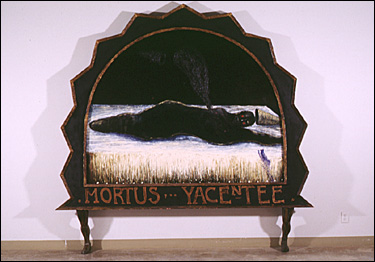
A self-taught artist, Colunga creates images that bring to mind popular art traditions in Mexico. The imagery in La muerte del payaso iv (The Death of the Clown IV) is drawn from his personal experiences working for a circus and his staunch Catholic upbringing.
La muerte del payaso iv, 1993. Alejandro Colunga (Mexican). Oil and mixed media on canvas: 99" x 102". Purchased with Ewing Halsell Funds.
Colunga cites Rufino Tamayo as one of the artists who have influenced him. An admiration for Mexican folk art is evident in his work, as is a familiarity with the art of India and other cultures. Colunga has studied in the workshops of master artisans in Mexico and often uses traditional techniques in ceramics and wood sculpture.
Much of Colunga’s imagery is based on folk stories he heard as a child. Characters like La Llorona (The Weeping Woman) and Chamuco (The Devil) appear in his work. He uses the device of exaggerating human anatomy (such as filling the canvas with a single figure whose head is tiny) along with exuberant color to create a sense of “bewitchment.”